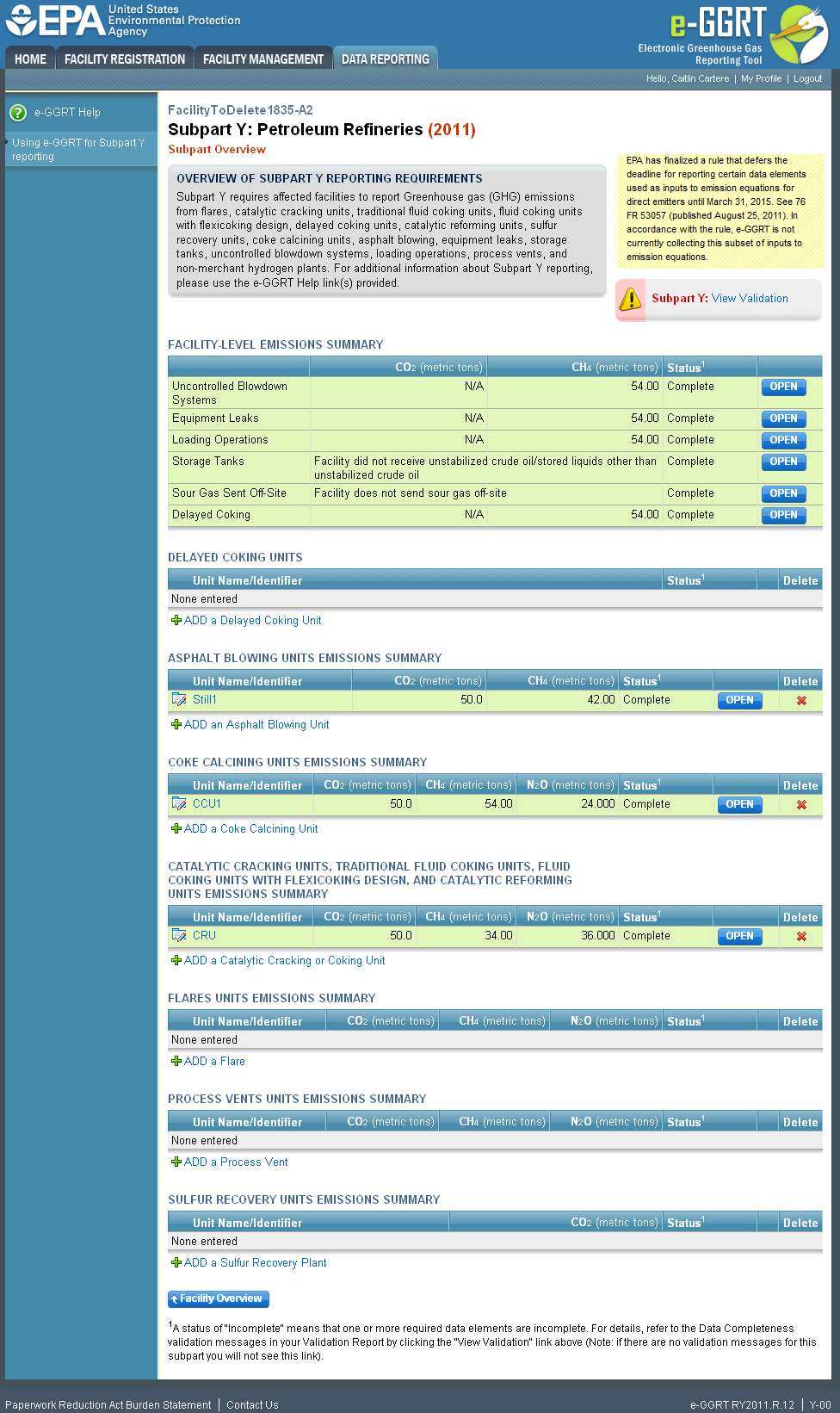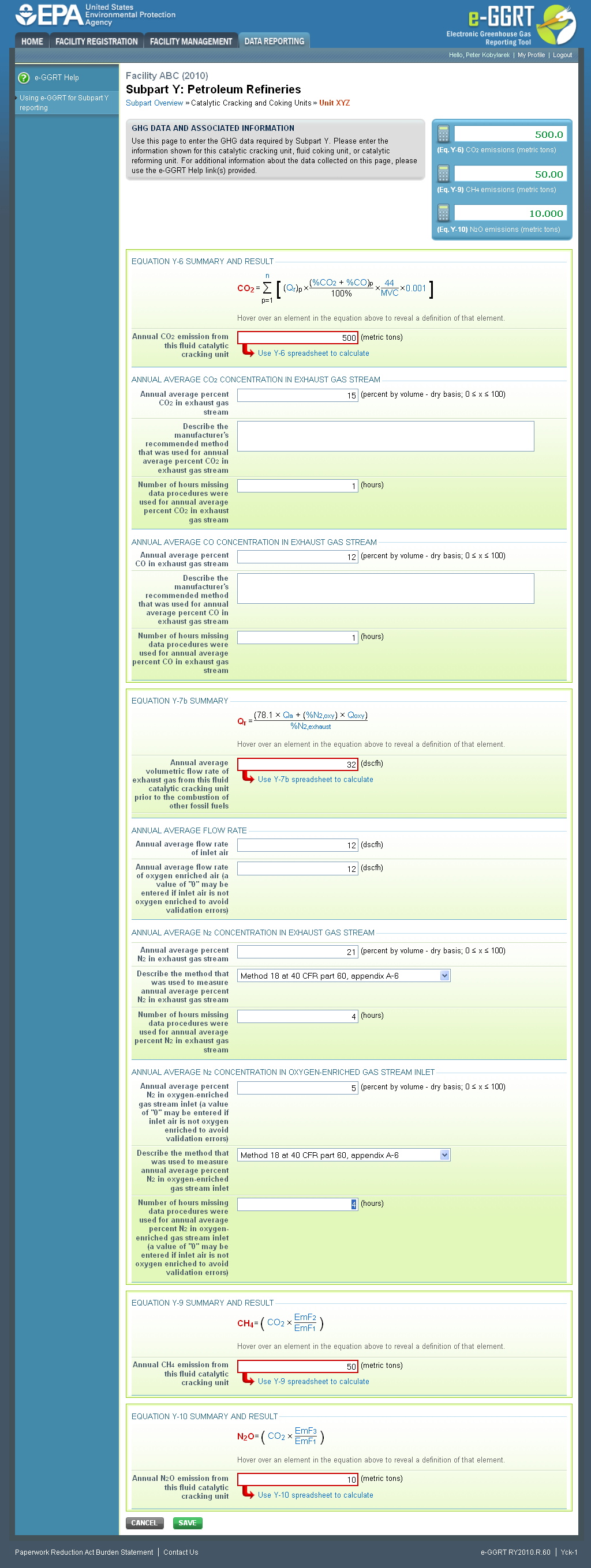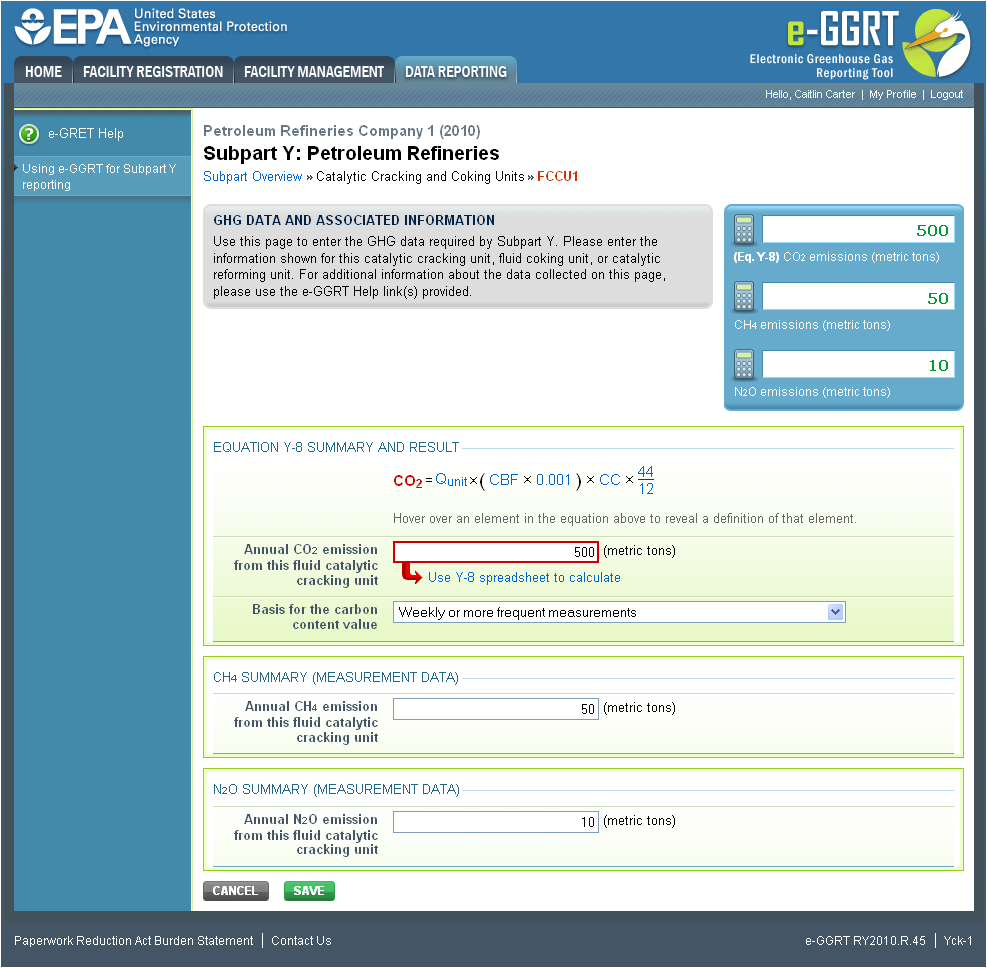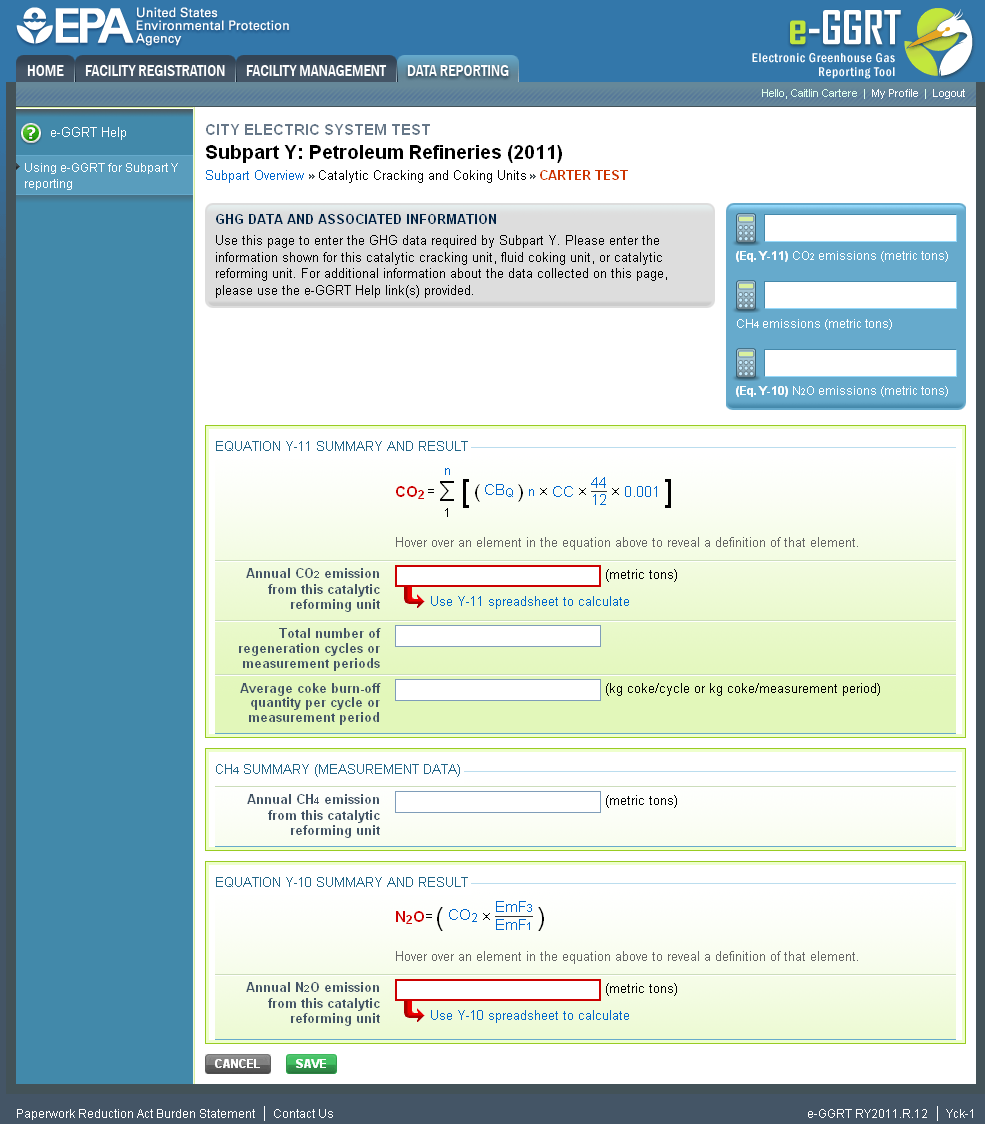...
To edit an existing Catalytic Cracking, Fluid Coking, or Catalytic Reforming Unit, click on the edit icon or the Name/ID link, which is the first column in the CATALYTIC CRACKING AND COKING UNIT-LEVEL UNITS, TRADITIONAL FLUID COKING UNITS, FLUID COKING UNITS WITH FLEXICOKING DESIGN, AND CATALYTIC REFORMING UNITS EMISSIONS SUMMARY table.
To delete an existing Catalytic Cracking, Fluid Coking, or Catalytic Reforming Unit, click on the delete icon, which is the last column in the CATALYTIC CRACKING UNITS, TRADITIONAL FLUID COKING UNITS, FLUID COKING UNITS WITH FLEXICOKING DESIGN, AND CATALYTIC REFORMING UNITS EMISSIONS SUMMARY table.
...
| Toggle Cloak | ||
|---|---|---|
|
| Cloak | ||||||
|---|---|---|---|---|---|---|
| ||||||
| |
...
- A unique name or identifier, plus optional description for this unit (see also About Unique Unit Names)
- Specify the type of unit:
- Fluid Catalytic Cracking Unit
- Thermal Catalytic Cracking Unit
- Traditional Fluid Coking Unit
- Catalytic Reforming Unit (see note below)
- Fluid Coking Unit with Flexicoking Design (see note below)
- For each unit, answer the following question: Do you operate and maintain a CEMS that measures CO2 emissions according to subpart C? This means that both a flow meter and a concentration monitor need to be installed. If so, you must use the CEMS methodology for measuring CO2 emissions from this unit. Click either Yes or No.
...
For
...
For Fluid Coking Units with Flexicoking Design, you will be asked if the GHG emissions from the low heat value gas are accounted for in Subpart C.
Fluid Coking Units with Flexicoking Design, you will be asked if the GHG emissions from the low heat value gas are accounted for in Subpart C.
- If your
...
- answer to this question is 'yes', you are only required to report maximum rated throughput of the fluid coking unit with flexicoking design
- If your answer to this question is 'no', you are required to report maximum rated throughput of the fluid coking unit with flexicoking design and the methods used to calculate emissions per the sections below
When you are finished entering the required information, click NEXT.
...
| Toggle Cloak | ||
|---|---|---|
|
| Cloak | ||||||
|---|---|---|---|---|---|---|
| ||||||
| |
...
When you are finished entering the required information, click SAVE.
| Toggle Cloak | ||
|---|---|---|
|
...
| cloak.toggle.zone | true |
|---|---|
| id | PNG4 |
| cloak.toggle.type | none |
click SAVE.
Adding or Updating Catalytic Cracking or Coking Unit Emissions Information
...
| Toggle Cloak | ||
|---|---|---|
|
| Cloak | ||||||
|---|---|---|---|---|---|---|
| ||||||
| |
| Note |
|---|
Depending on the methods selected to calculate CO2, CH4 and N2O emissions (see previous section titled "Adding or Updating Catalytic Cracking, Fluid Coking, or Coking Catalytic Reforming Unit Information"), you will be presented with screens to collect the respective CO2, CH4 and N2O emission results and additional data. Each specific screen is discussed below. |
...
The annual CO2 emission rate from the unit operations is required. To calculate this value download the spreadsheet by clicking the link titled "Use Y-6 spreadsheet to calculate." Fill in the spreadsheet using the instructions in the spreadsheet. After completing the spreadsheet, copy the value of CO2 calculated by the spreadsheet to this page in the box next to "Annual CO2 emission from this unit type unit (metric tons)."
Subpart Y also collects the following CO2 emission data:
- Annual average flow rate of exhaust gas (dscfh)
- Manufacturer's recommended method used for annual average flow rate of exhaust gas
- Number of hours missing data procedures were used for annual average flow rate of exhaust gas (hours)
- Annual average percent CO2 in exhaust gas stream (percent by volume - dry basis; 0 ? x ? 100)
- Manufacturer's recommended method used for annual average percent CO2 in exhaust gas stream
- Number of hours missing data procedures were used for annual average percent CO2 in exhaust gas stream (hours)
- Annual average percent CO in exhaust gas stream (percent by volume - dry basis; 0 ? x ? 100)
- Manufacturer's recommended method used for annual average percent CO in exhaust gas stream
- Number of hours missing data procedures were used for annual average percent CO in exhaust gas stream (hours)
...
CO2 Emissions Calculation: 98.253(c)(2) – Equation Y-6 and Y-7a
The annual CO2 emission rate emissions from the unit operations is required. To calculate this value download the spreadsheet by clicking the link titled "Use Y-6 and Y-7a spreadsheet to calculate." Fill in the spreadsheet using the instructions in the spreadsheet. After completing the spreadsheet, copy the value of CO2 calculated by the spreadsheet to this page in the box next to "Annual CO2 emission from this unit type unit (metric tons)."
The Equation Y-6 and Y-7a Summaries are presented on the page. You can hover over an element in the equation to reveal a definition of that element.
...
- Annual CO2 emission from this unit (metric tons)
- Annual average percent CO2 in exhaust gas stream (percent by volume - dry basis; 0 ? x ? 100)
- Describe the manufacturer's recommended method that was used for annual average percent CO2 in exhaust gas stream
- Number of hours missing data procedures were used for annual average percent CO2 in exhaust gas stream (hours)
- Annual average percent CO in exhaust gas stream (percent by volume - dry basis; 0 ? x ? 100)
- Describe the manufacturer's recommended method that was used for annual average percent CO in exhaust gas stream
- Number of hours missing data procedures were used for annual average percent CO in exhaust gas stream (hours)
- Annual average volumetric flow rate of exhaust gas from this unit prior to the combustion of other fossil fuels (dscfh)
- Annual average flow rate of inlet air (dscfh)
- Annual average flow rate of oxygen enriched air (a value of "0" may be entered if inlet air is not oxygen enriched to avoid validation errors) (dscfh)
- Annual average percent O2 O2 in exhaust gas stream (percent by volume - dry basis; 0 ? x ? 100)
- Describe the manufacturer's recommended method that was used for annual average percent O2 O2 in exhaust gas stream
- Number of hours missing data procedures were used for annual average percent O2 O2 in exhaust gas stream (hours)
- Annual average percent O2 O2 in oxygen-enriched gas stream inlet (a value of "0" may be entered if inlet air is not oxygen enriched to avoid validation errors) (percent by volume - dry basis; 0 ? x ? 100)
...
CO2 Emissions Calculation: 98.253(c)(2) – Equation Y-6 and Y-7b
The annual CO2 emission rate emissions from the unit operations is required. To calculate this value download the spreadsheet by clicking the link titled "Use Y-6 and Y-7b spreadsheet to calculate." Fill in the spreadsheet using the instructions in the spreadsheet. After completing the spreadsheet, copy the value of CO2 calculated by the spreadsheet to this page in the box next to "Annual CO2 emission from this unit type unit (metric tons)."
Subpart Y also collects the following CO2 emission data:
Annual CO2 emission from this
...
unit type unit (metric tons)."
Subpart Y also collects the following CO2 emission data:
- Annual CO2 emission from this unit (metric tons
- Annual average percent CO2 in exhaust gas stream (percent by volume - dry basis; 0 < x < 100)
- Describe the manufacturer's recommended method that was used for annual average percent CO2 in exhaust gas stream
- Number of hours missing data procedures were used for annual average percent CO2 in exhaust gas stream (hours)
- Annual average percent CO2 in exhaust gas stream (percent by volume - dry basis; 0 < ? x < ? 100)
- Describe the manufacturer's recommended method that was used for annual average percent CO in exhaust gas stream
- Number of hours missing data procedures were used for annual average percent CO in exhaust gas stream (hours)
- Annual average volumetric flow rate of exhaust gas from this fluid catalytic cracking unit prior to the combustion of other fossil fuels (dscfh)
- Annual average flow rate of inlet air (dscfh)
- 2 in exhaust gas stream
- Number of hours missing data procedures were used for annual average percent CO2 in exhaust gas stream (hoursAnnual average flow rate of oxygen enriched air (a value of "0" may be entered if inlet air is not oxygen enriched to avoid validation errors) (dscfh)
- Annual average percent N2 CO in exhaust gas stream (percent by volume - dry basis; 0 < ? x < 100)
- Describe the method that was used to measure annual average percent N2 in exhaust gas stream:
- Method 18 at 50 CFR part 60, appendix A-6
- ASTM D1945-03
- ASTM D1946-90-Reapproved 2006
- GPA 2261-00
- UOP539-97
- ASTM D2503-92-Reapproved 2007
- Chromatographic analysis: manufacturer's instructions
- Maximum N2 impurity specification
- Other (specify)
- ? 100)
- Describe the manufacturer's recommended method that was used for annual average percent CO in exhaust gas stream
- Number of hours missing data procedures were used for annual average percent N2 in exhaust gas stream (hours)used for annual average percent CO in exhaust gas stream (hours)
- Annual average volumetric flow rate of exhaust gas from this unit prior to the combustion of other fossil fuels (dscfh)
- Annual average flow rate of inlet air (dscfh)
- Annual average flow rate of oxygen enriched air Annual average percent N2 in oxygen-enriched gas stream inlet (a value of "0" may be entered if inlet air is not oxygen enriched to avoid validation errors) (dscfh)
- Annual average percent N2 in exhaust gas stream (percent by volume - dry basis; 0 < ? x < ? 100)
- Describe the method that was used to measure annual average percent N2 in oxygen-enriched exhaust gas stream inlet:
- Method 18 at 50 CFR part 60, appendix A-6
- ASTM D1945-03
- ASTM D1946-90-Reapproved 2006
- GPA 2261-00
- UOP539-97
- ASTM D2503-92-Reapproved 2007
- Chromatographic analysis: manufacturer's instructions
- Maximum N2 impurity specification
- Other (specify)
- Number of hours missing data procedures were used for annual average percent N2 in exhaust gas stream (hours)
- Annual were used for annual average percent N2 in oxygen-enriched gas stream inlet (a value of "0" may be entered if inlet air is not oxygen enriched to avoid validation errors) (hours)
| Note |
|---|
If the gas stream in question does not contain any oxygen-enrichment, then a value of zero may be entered for questions related to oxygen-enrichment. |
The Equation Y-6 and Y-7b Summaries are presented in the screenshot below. You can hover over an element in the equation to reveal a definition of that element.
...
| Toggle Cloak | ||
|---|---|---|
|
...
| cloak.toggle.zone | true |
|---|---|
| id | PNG8 |
| cloak.toggle.type | none |
CO2 Emissions Calculation: 98.253(c)(3) – Equation Y-8
The annual CO2 emission rate from the unit operations is required. To calculate this value download the spreadsheet by clicking the link titled "Use Y-8 spreadsheet to calculate." Fill in the spreadsheet using the instructions in the spreadsheet. After completing the spreadsheet, copy the value of CO2 calculated by the spreadsheet to this page in the box next to "Annual CO2 emission from this unit type unit (metric tons)."
For this method, Subpart Y also collects the basis for the carbon content value:
- Weekly or more frequent measurements
- Periodic (less frequent than weekly but at least quarterly) measurements
- Semi-annual or annual measurements
- Historical measurement value
- Engineering estimate
- Default value
- Other
The Equation Y-8 Summary is presented in the screenshot below. You can hover over an element in the equation to reveal a definition of that element
...
| Toggle Cloak | ||
|---|---|---|
|
...
| cloak.toggle.zone | true |
|---|---|
| id | PNG9 |
| cloak.toggle.type | none |
CO2 Emissions Calculation: 98.253(c)(3) - Equation Y-11
The annual CO2 emission rate from the unit operations is required. To calculate this value download the spreadsheet by clicking the link titled "Use Y-11 spreadsheet to calculate." Fill in the spreadsheet using the instructions in the spreadsheet. After completing the spreadsheet, copy the value of CO2 calculated by the spreadsheet to this page in the box next to "Annual CO2 emission from this unit type unit (metric tons)."
...
- percent by volume - dry basis; 0 ? x ? 100)
- Describe the method that was used to measure annual average percent N2 in oxygen-enriched gas stream inlet:
- Method 18 at 50 CFR part 60, appendix A-6
- ASTM D1945-03
- ASTM D1946-90-Reapproved 2006
- GPA 2261-00
- UOP539-97
- ASTM D2503-92-Reapproved 2007
- Chromatographic analysis: manufacturer's instructions
- Maximum N2 impurity specification
- Other (specify)
- Number of hours missing data procedures were used for annual average percent N2 in oxygen-enriched gas stream inlet (a value of "0" may be entered if inlet air is not oxygen enriched to avoid validation errors) (hours)
| Note |
|---|
If the gas stream in question does not contain any oxygen-enrichment, then a value of zero may be entered for questions related to oxygen-enrichment. |
The Equation Y-6 and Y-7b Summaries are presented in the screenshot below. You can hover over an element in the equation to reveal a definition of that element.
| Composition Setup |
|---|
| Toggle Cloak | ||
|---|---|---|
|
| Cloak | ||||||
|---|---|---|---|---|---|---|
| ||||||
| |
CO2 Emissions Calculation: 98.253(c)(3) – Equation Y-8
The annual CO2 emissions from the unit operations is required. To calculate this value download the spreadsheet by clicking the link titled "Use Y-8 spreadsheet to calculate." Fill in the spreadsheet using the instructions in the spreadsheet. After completing the spreadsheet, copy the value of CO2 calculated by the spreadsheet to this page in the box next to "Annual CO2 emission from this unit type unit (metric tons)."
For this method, Subpart Y also collects the basis for the carbon content value:
- Weekly or more frequent measurements
- Periodic (less frequent than weekly but at least quarterly) measurements
- Semi-annual or annual measurements
- Historical measurement value
- Engineering estimate
- Default value
- Other (specify)
The Equation Y-8 Summary is presented in the screenshot below. You can hover over an element in the equation to reveal a definition of that element
| Composition Setup |
|---|
| Toggle Cloak | ||
|---|---|---|
|
| Cloak | ||||||
|---|---|---|---|---|---|---|
| ||||||
| |
CO2 Emissions Calculation: 98.253(c)(3) - Equation Y-11
The annual CO2 emissions from the unit operations is required. To calculate this value download the spreadsheet by clicking the link titled "Use Y-11 spreadsheet to calculate." Fill in the spreadsheet using the instructions in the spreadsheet. After completing the spreadsheet, copy the value of CO2 calculated by the spreadsheet to this page in the box next to "Annual CO2 emission from this catalytic reforming unit (metric tons)."
For this method, Subpart Y also collects the total number of regeneration cycles or measurement periods, as well as the average coke burn-off quantity per cycle or measurement period.
The Equation Y-11 Summary is presented in the screenshot below. You can hover over an element in the equation to reveal a definition of that element.
| Composition Setup |
|---|
| Toggle Cloak | ||
|---|---|---|
|
| Cloak | ||||||
|---|---|---|---|---|---|---|
| ||||||
| |
CH4 Emissions Calculation: Equation Y-9
The annual CH4 emission rate emissions from the unit operations is required. To calculate this value download the spreadsheet by clicking the link titled "Use Y-9 spreadsheet to calculate." Fill in the spreadsheet using the instructions in the spreadsheet. After completing the spreadsheet, copy the value of CH4 calculated by the spreadsheet to this page in the box next to "Annual CH4 emission from this unit type unit (metric tons)."
...
N2O Emissions Calculation: Equation Y-10
The annual N2O emission rate emissions from the unit operations is required. To calculate this value download the spreadsheet by clicking the link titled "Use Y-10 spreadsheet to calculate." Fill in the spreadsheet using the instructions in the spreadsheet. After completing the spreadsheet, copy the value of N2O calculated by the spreadsheet to this page in the box next to "Annual N2O emission from this unit type unit (metric tons)."
The Equation Y-10 Summary is presented in the screenshot below. You can hover over an element in the equation to reveal a definition of that element.
...












